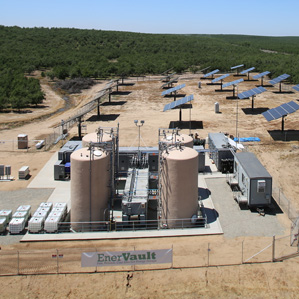A Battery Made of Iron Could Improve the Economics of Solar and Wind Power
At a small solar power plant near Modesto, in California’s Central Valley, a startup called Enervault recently unveiled battery technology that could increase the amount of renewable energy utilities can use. The technology is based on inexpensive materials that researchers had largely given up on because batteries made from them didn’t last long enough to be practical. But the company says it has figured out how to make the batteries last for decades.

The technology is being demonstrated in a large battery that stores one megawatt-hour of electricity, enough to run 10,000 100-watt light bulbs for an hour. Enervault says its batteries could compete with the cheapest form of electricity storage available today—pumping water up a hill so that it can spin turbines as it flows back down, which is feasible only in certain locations. The company has been testing a similar, though much smaller, version of the technology for about two years with good results. It has raised $30 million in funding, including a $5 million grant from the U.S. Department of Energy.
The batteries are particularly well suited to storing large amounts of energy, such as hours of output from a wind farm or solar plant. They could thereby help solve a big problem with renewables: sometimes they generate electricity when not much is needed, such as in the early morning hours or on cool, sunny weekend days.
The technology is a type of flow battery, so called because the energy storage materials are in liquid form. They are stored in big tanks until they’re needed; then they’re pumped through a relatively small device, called a stack, where they interact to generate electricity. Building bigger tanks is relatively cheap, so the more energy storage is needed, the better the economics become. That means the batteries are best suited for storing hours’ or days’ worth of electricity, not delivering quick bursts.
Enervault’s particular version of the technology uses water, chromium, and iron—cheap, safe materials that had been tried in batteries in the 1970s. But unwanted chemical reactions such as the release of hydrogen caused them to degrade, decreasing the amount of energy they could store.
“By proving that the unwanted reactions are reversible, we’ve solved the problems with iron-chromium chemistry,” says Enervault CEO Jim Pape. The company says the energy storage materials can last for more than 20 years.
One significant drawback to the technology is that it’s less than 70 percent efficient—30 percent of the electricity used to charge the battery is lost (many batteries are better than 90 percent efficient). The company says the economics still work out, but such a wasteful battery might not be ideal for large-scale renewable energy. More solar panels would have to be installed to make up for the waste.
Enervault says that when the batteries are produced commercially at even larger sizes than the current demonstration model, they will cost just a fifth as much as vanadium redox flow batteries, which have been demonstrated at large scales and are probably the type of flow battery closest to market right now. Researchers at Harvard recently made a flow battery that could prove cheaper than Enervault’s, but the prototype is small and could take many years to turn into a marketable version (see “New Battery Material Could Help Wind and Solar Power Go Big”). An MIT spinoff, Sun Catalytix, is also developing an advanced flow battery, but its prototype is also small (see “Startup Shows Off Its Cheaper Grid Battery”). Other types of inexpensive, long-duration batteries are being developed, using materials such as molten metals (see “Ambri Funding Influx Suggests a New Day for Grid Batteries”).
The market for batteries designed to store hours of electricity is still uncertain. A combination of advanced weather forecasts, responsive fossil-fuel power plants, better transmission networks, and smart controls for wind and solar power could delay the need for them (see “Smart Wind and Solar Power”). California is requiring its utilities to invest in energy storage but hasn’t specified what kind, and it’s not clear what types of batteries will prove most valuable in the near term—slow-charging ones like Enervault’s or those that deliver quicker bursts of power to make up for short-term variations in energy supply. Tesla Motors, one company developing the latter type, hopes to make them affordable by producing them at a huge factory (see “Tesla Plans to Start Building its Gigafactory Next Month”).
Keep Reading
Most Popular
Large language models can do jaw-dropping things. But nobody knows exactly why.
And that's a problem. Figuring it out is one of the biggest scientific puzzles of our time and a crucial step towards controlling more powerful future models.
How scientists traced a mysterious covid case back to six toilets
When wastewater surveillance turns into a hunt for a single infected individual, the ethics get tricky.
The problem with plug-in hybrids? Their drivers.
Plug-in hybrids are often sold as a transition to EVs, but new data from Europe shows we’re still underestimating the emissions they produce.
Stay connected
Get the latest updates from
MIT Technology Review
Discover special offers, top stories, upcoming events, and more.